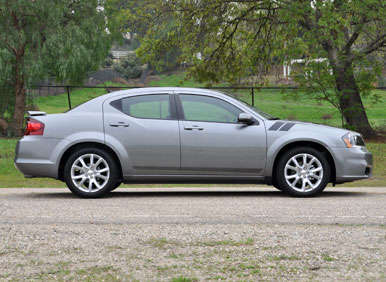Recent Articles
Popular Makes
Body Types
2013 Dodge Avenger Road Test and Review
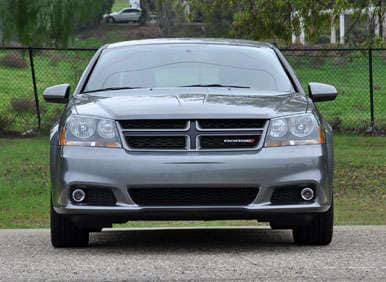
Dodge introduced the Avenger for the 2008 model year, a dark time in parent company Chrysler’s history. An underfunded project from the start, the Avenger launched just as Daimler and Chrysler were getting a divorce, and no amount of Charger Jr. styling could mask its underwhelming engineering and cheap construction. As a result, Dodge was forced to offer big discounts to sell Avengers to consumers, and needed to place large numbers of Avengers in rental car fleets in order to keep the factory running and to recoup as much investment as possible.
The vehicle shown here is not a rental car. It is a 2013 Dodge Avenger, yes, but this is the sporty R/T model, something you’re unlikely to find sitting in a parking lot adjacent to an airport. Historically, Dodge has employed the R/T designation to infer capability both on the road and at the track. This is marketing hyperbole, of course, yet the 2013 Dodge Avenger R/T is a much better car than its critics might claim, in part due to a significant upgrade bestowed upon the model a couple of years ago, an effort that fixed many of the things that were wrong with the car, but not all of them.
Positioned as a midsize family car, the Avenger is sandwiched between the new Dodge Dart, which is almost as big as the Avenger on the inside, and the Dodge Charger, a larger and more substantial car than the Avenger. If the Avenger is a tough sell within the Dodge lineup, it’s even more difficult to recommend in comparison to midsize sedans from other car companies. Where the Avenger makes the best case for itself is in terms of value, but that value comes at a cost.
2013 Dodge Avenger Road Test and Review: Models and Prices
Dodge sells the 2013 Avenger in SE ($19,990 – including the $995 destination charge), SXT ($22,690), and R/T ($26,490) trim levels, overlapping the best-equipped versions of the Dart on the low end and the base Charger on the high end. Standard equipment for the Avenger SE includes air conditioning, power windows, power mirrors, power door locks, remote keyless entry, cruise control, a tilt-and-telescopic steering wheel, and a stereo with a CD player, satellite radio, and an auxiliary audio input jack. The Avenger SE rides on humble 17-inch steel wheels with plastic wheel covers.
The Avenger SXT is better equipped, offering 17-inch aluminum wheels and a 6-speed automatic transmission that replaces the standard 4-speed automatic. Additionally, the Avenger SXT includes automatic headlights, fog lights, heated side mirrors, a better sound system, automatic climate control, an 8-way power driver’s seat, a leather-wrapped steering wheel and shift knob, a trip computer, LED cabin lighting, and more. Dodge also offers the Avenger SXT with a Rallye Appearance Group (18-inch aluminum wheels, body-color grille, darkened headlamp backgrounds, rear spoiler) and a Blacktop Package (same thing but with black wheels and a black grille).
At the top of the lineup, the Avenger R/T is equipped with a standard 3.6-liter V-6 engine, and adds a sport-tuned suspension, 18-inch aluminum wheels, darkened headlamp backgrounds, and R/T fender stripes. Inside, the Avenger R/T is equipped with leather-bolstered seats with striped fabric inserts, heated front seats, perforated leather for the steering wheel, metallic pedals, and a special gauge cluster with a center-mounted tachometer. Additional upgrades include red ambient interior lighting, Boston Acoustics audio, Bluetooth connectivity, and a universal remote control.
My test car was a Tungsten Metallic Avenger R/T equipped with the optional Sun and Navigation Group, which added a power sunroof and a Uconnect touchscreen infotainment system with voice-recognition technology, a navigation system, a 20-gig music hard drive, Bluetooth streaming audio, and real-time traffic reports. The window sticker read $27,930. As this review is written, Dodge is offering a choice between 0% financing for 72 months and a rebate of $2,500 for all Avengers.
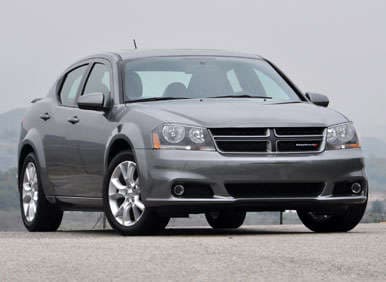
2013 Dodge Avenger Road Test and Review: Design
- Standard automatic headlights and fog lights for SXT model
- Optional SXT Rallye Appearance Group
- Optional Blacktop Package
- Three new paint colors
Styled to resemble the Dodge Charger, the Avenger’s contrived design looks awkward on this shorter and narrower platform, the oversized headlights, rear haunches, and flared wheel arches exaggerated to almost cartoonish proportions. The bigger 18-inch aluminum wheels that come standard on the Avenger R/T certainly help to balance things out, but they still look too small for the car. A pedestal-style rear wing spoiler and fender stripes are standard for the R/T model, but more conservative buyers can request that the stripes are deleted.
Inside, the Avenger is equipped with a surprisingly sophisticated cabin. The soft-touch dashboard is a clean design with a classy leather pattern that is used consistently throughout the interior. Plastic pillar covers match the appearance and texture of the headliner material, and nearly everything the driver can see and touch looks and feels richer than expectations set by the Avenger’s price tag.
Unfortunately, the turn signal stalk serves as constant reminder that this is an old and inexpensive car built to a low price point. Every single time the driver signals, the stalk feels and sounds like a snapping chicken bone.
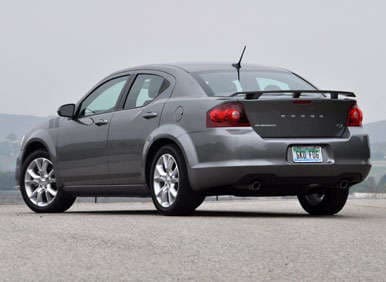
2013 Dodge Avenger Road Test and Review: Comfort and Cargo
- Optional leather seats for SXT model
- Optional heated front seats for SXT model
Despite the Avenger’s rather small stature, the car provides plenty of room for four people. Notice that I did not write comfort for four people. The Avenger R/T’s power driver’s seat is adequate, offering decent thigh support and lateral bolstering, but no more. My test car had 4,000 miles on it, and the left leather bottom seat bolster already looked like perhaps the vehicle had clocked 40,000 miles. On a positive note, the Avenger supplies soft surfaces where the driver is most likely to rest an arm or elbow, and the R/T model’s thick-rimmed steering wheel is comfortable to grip, wrapped in a smooth, high-quality leather.
The front passenger’s seat is just as comfortable as the driver’s seat, despite its lack of power adjustment, placing its occupant high enough off of the floor for comfort and outward visibility. Adults will not want to spend much time sitting in the Avenger’s back seat, however, because it is flat, mounted low in the vehicle, and provides no lateral or thigh support. This would not be a good place to sit for long periods of time, despite the softly padded front seat backs and an impressive amount of foot space.
The Avenger’s small greenhouse and thick roof pillars compromise outward visibility. Making matters worse, a reversing camera is unavailable for this model. The side mirrors, however, are commendably large and provide a good view to the sides of the vehicle.
Gas-charged struts support the Avenger’s trunk lid, a sophisticated solution that eliminates the possibility of crushing cargo when slamming the lid shut. Owners can, therefore, pack this Dodge’s trunk to maximum capacity of 13.5 cu.-ft., a small amount of space for a midsize car.
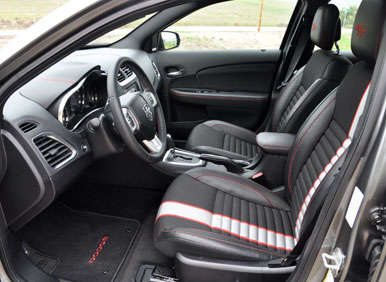
2013 Dodge Avenger Road Test and Review: Features and Controls
- No changes for 2013
Equipped with three large gauges, the Avenger should supply clarity with regard to communicating vehicle information. It doesn’t. In the R/T model, the tachometer is presented as the largest gauge in the center of the cluster, a silly affectation in a sporty family sedan that’s only offered with an automatic transmission. The speedometer is relegated to the right binnacle, where the driver’s right hand often blocks it. Tiny, illegible gauge markings certainly don’t help matters.
An older version of Chrysler’s Uconnect technology is included in the Avenger R/T’s Sun and Navigation Group, offering a 6.5-inch color touchscreen that lacks the sophistication of the latest Uconnect 8.4 technology, but which remains easy and intuitive to use. Easy and intuitive also describes the rest of the Avenger’s interior, from the steering wheel buttons for cycling through trip computer menus to the large, round knobs that operate the climate control system.
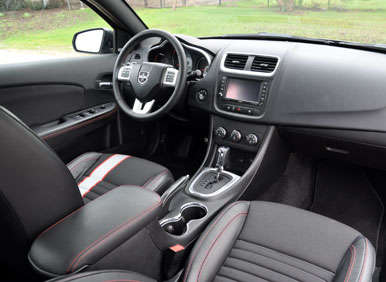
2013 Dodge Avenger Road Test and Review: Safety and Ratings
- No changes for 2013
Considering that the 2013 Avenger can’t be equipped with a simple reversing camera, it comes as no surprise to learn that the car also lacks modern safety technologies that are offered on competing models. That leaves the basics: six airbags, traction and stability control, and 4-wheel-disc antilock brakes.
Depending on the source consulted, the 2013 Dodge Avenger’s crash-test ratings are in need of improvement or are among the best in the midsize sedan class. Let me explain.
The NHTSA gives the 2013 Avenger an overall crash-test rating of 4 stars. Dig deeper, and you’ll see that the car receives a 3-star rating for the front seat occupant in a frontal-impact collision, a 3-star rating for the driver in a side-impact collision, and a 2-star rating for the driver in a side-impact crash with a pole or a tree. Not good.
The Insurance Institute for Highway Safety (IIHS) paints a very different picture of Avenger safety, even naming the car a “Top Safety Pick Plus” thanks to its “Acceptable” rating in the new small overlap frontal-impact test. The IIHS tests measure crash safety differently than the NHTSA, and the IIHS asserts that its testing regimen more closely mimics crashes that occur in the real world.
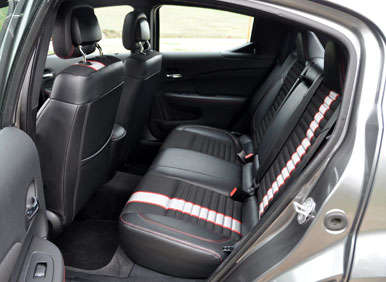
2013 Dodge Avenger Road Test and Review: Engines and Fuel Economy
- No changes for 2013
Dodge offers a choice of engines for the 2013 Dodge Avenger. The SE and SXT models are equipped with a 173-horsepower, 2.4-liter 4-cylinder engine charged with motivating 3,400 lbs. of sedan. The 4-cylinder engine makes 173 horsepower and 166 lb.-ft. of torque, and is paired with a 4-speed automatic transmission in Avenger SE models. The Avenger SXT has a 6-speed automatic. According to the EPA, the 4-speed automatic gets better fuel economy, rated 24 mpg in combined driving compared to 23 mpg for the 6-speed automatic.
A 3.6-liter V-6 engine is optional for the SE and the SXT, and standard for the Avenger R/T. The V-6 makes 283 horsepower and 260 lb.-ft. of torque, plenty to get the Avenger up to speed with surprising alacrity. A 6-speed automatic is included with the V-6 engine, and the EPA says this powertrain combination should return 22 mpg in combined driving. We averaged 22.3 mpg.
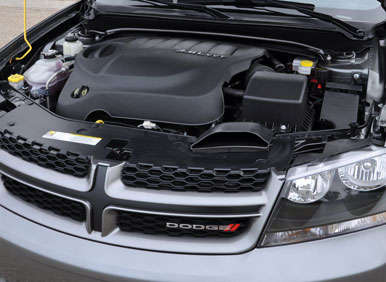
2013 Dodge Avenger Road Test and Review: Driving Impressions
At the risk of losing all credibility, I’m going to say that the 2013 Dodge Avenger R/T is unexpectedly good to drive. It is fast, it is quiet, it is reasonably fuel efficient, and it is remarkably capable given its age and humble origins.
Let’s start with the 3.6-liter V-6 engine, which Ward’s Auto named to its “10 Best Engines” list for 2013. With just 3,607 lbs. of Avenger R/T to motivate, this V-6 delivers effortless acceleration, the transmission shifting into higher gears as soon as is practical in an effort to conserve fuel. Punching the gas introduces torque steer to the festivities, and the transmission occasionally delays downshifts as though it is gauging just how serious the driver is about demands for extra power.
In terms of the Avenger R/T’s driving dynamics, I expected none, but then it had been five years since I’d last driven an Avenger. To summarize, I would say that the 2013 Dodge Avenger R/T is a perfect example illustrating the benefits of employing talented people to sweat details.
When Dodge decided to perform a significant mid-life update for the Avenger, it focused resources on fixing what was wrong, and keeping what was right, or at least acceptable. The result is an Avenger R/T that is deceptively quick and surprisingly agile on twisty mountain roads, yet comfortable and compliant on city streets and freeways. What’s lacking here is crisp and clear communication between the mechanicals and the driver, a level of engagement that could make an Avenger genuinely fun to drive.
Riding on a 4-wheel-independent suspension, 18-inch wheels, and P225/50R18 Goodyear Eagle LS tires, the Avenger R/T’s weight distribution puts 60% of the poundage over the car’s front wheels. Naturally, then, one might expect the car to push wide in corners taken with gusto. I did not find this to be the case. Not only did the Avenger R/T provide confident grip, the tires uttered nary a squeal as I tossed the Dodge into turn after curve after kink in Mulholland Highway’s blacktop.
Though agile, the Dodge does exhibit a greater degree of body motion than is preferable. The Avenger R/T’s sport suspension might be tauter than what’s installed in other models, but it remains compliant, allowing a perceptible degree of dive, squat, and roll when exercising the car. Of course, this same approach to suspension tuning also provides a superior ride quality, and the Avenger R/T soaked up scarred concrete that has other models doing a jitterbug.
The braking components disappointed in that they began to fade and shudder early in the Santa Monica Mountains torture test, and I was driving the car on a chilly day with temperatures in the mid 50s. Under normal circumstances, however, the Avenger’s brakes work fine, the pedal supplying good feel and modulation.
Similarly, the Avenger R/T’s steering draws neither praise nor scorn during normal, everyday driving, providing light-effort response to input and resolute on-center stability. As speeds rise, however, and as the road starts to twist, the steering becomes less satisfying, in part because it delivers little in terms of feel for the road, and in part because it is slow and requires the driver to feed more direction than ought to be required.
Finally, I must address how quiet and isolated the Dodge Avenger’s cabin is. Cruising along the Pacific coast as a winter storm barreled into Southern California, the only sound entering the cabin at 60 mph was the result of wind battering the driver’s side windshield pillar. Buick makes a big deal about QuietTuning in its vehicles, but this Avenger proved utterly silent at speed.
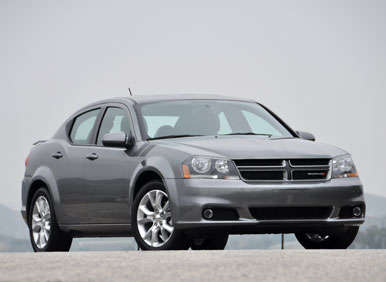
2013 Dodge Avenger Road Test and Review: Final Thoughts
The 2013 Dodge Avenger is not a competitive midsize family sedan by size, comfort, and safety feature measurements, but neither is it without merit, especially in SXT or R/T trim. There’s genuine value here, starting with a low price tag made more attractive by dealers who want to make a deal. Plus, the Avenger is a crash-test rock star by IIHS standards. And with the V-6 engine, it sure is a speedy machine. The Avenger R/T even displays some actual dynamic talent.
Still, that low price tag is accompanied by a low resale value, the “cost” that I alluded to in the introduction to this review. For that reason, I recommend searching for a low-mileage, certified pre-owned Dodge Avenger, if you decide you even want one in the first place.
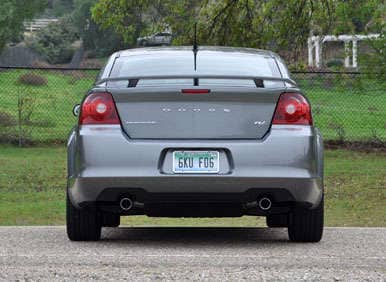
2013 Dodge Avenger Road Test and Review: Pros and Cons
- Low sticker price
- Powerful V-6 engine
- Capable handling
- Utterly silent cabin on the highway
- “Top Safety Pick Plus” rating from the IIHS
- Always offered with big discounts
- Cartoonish design
- Lacks safety technologies
- Unimpressive NHTSA crash-test ratings
- Uncomfortable back seat
- Small trunk
- Can’t hold its value over time
Dodge supplied the vehicle for this review
2013 Dodge Avenger R/T photos by Christian Wardlaw
